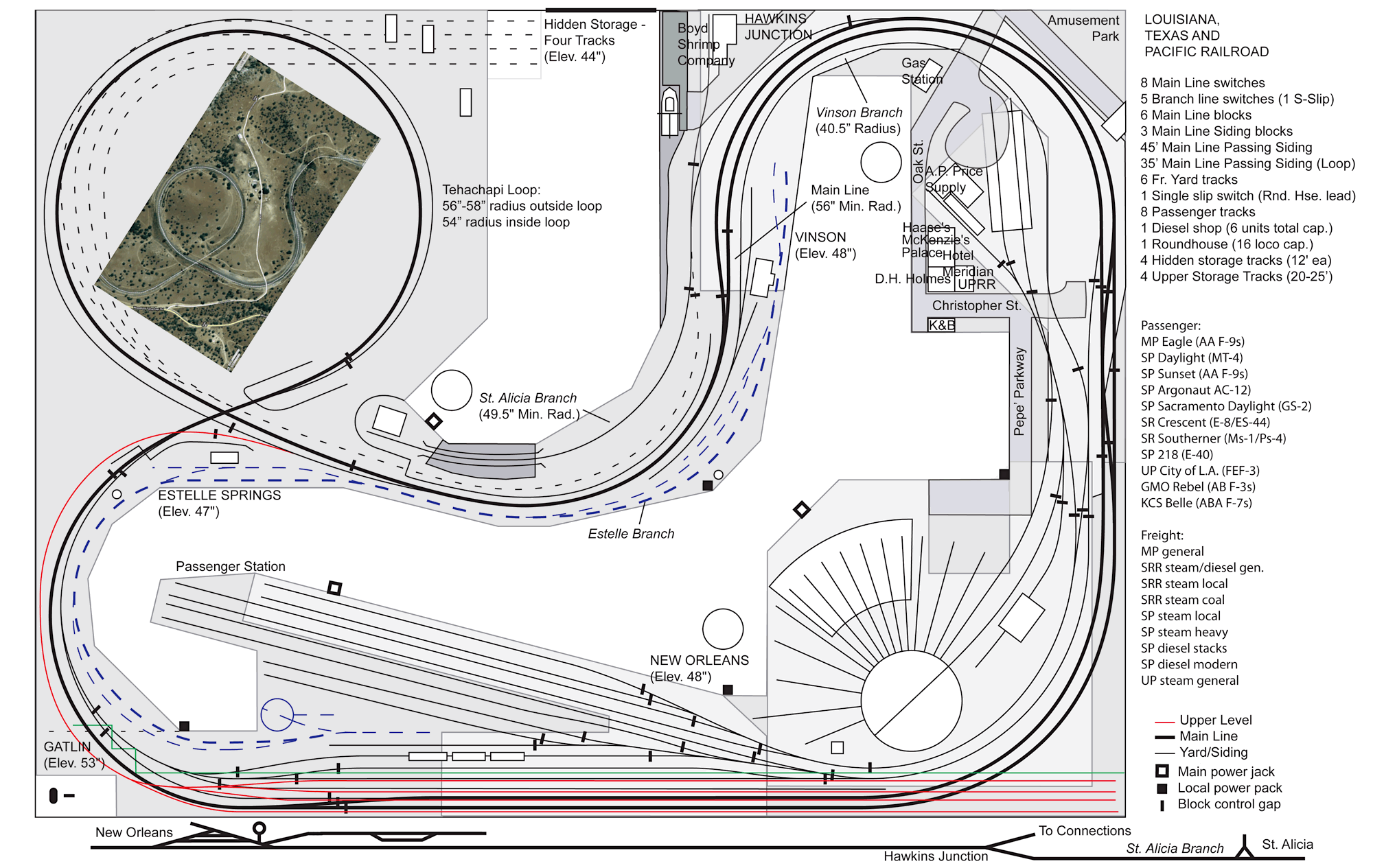
 |
Louisiana, Texas & Pacific Railroad Indoor Division - O Scale |
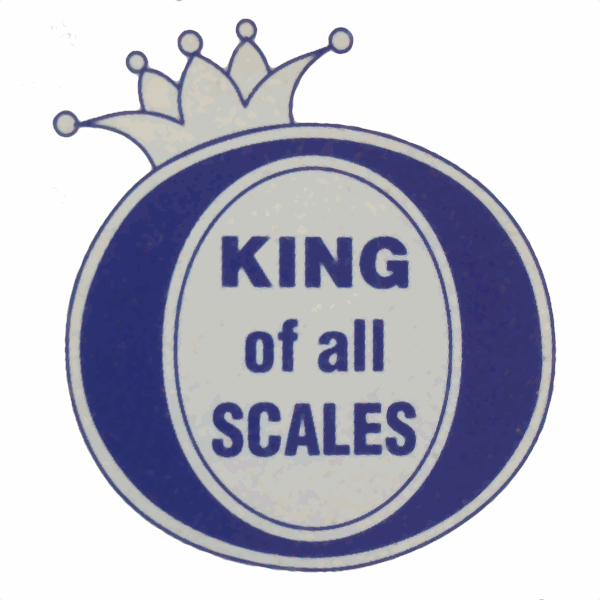
 he Indoor Division of the Louisiana, Texas & Pacific Railroad is the O scale layout of Gordon and James Payne, father and son. Utilizing some components from previous layouts, the current facility features scale 1:48 locomotives and rolling stock representing favorite mainline fallen flags from the greater New Orleans region, especially Southern Pacific, Missouri Pacific, Kansas City Souther, and the Southern Railway. Passenger equipment honors classic southern trains such as the Daylight, the Argonaut, the Belle, the Rebel, and the Crescent. The route features a 54 to 58" radius version of Tehachapi Loop, including a 35' passing siding. Mainline passenger and freight movements traverse the layout through 6 mainline blocks, crossing 8 mainline switches, passing a 16-stall roundhouse, a diesel shop, 6 freight yard tracks, and 8 passenger station tracks. The layout uses conventional DC power and includes both upper and lower storage yards for idled trains. The Indoor Division room also features an affiliated N Scale layout, conveniently tucked in underneath the O scale benchwork.
he Indoor Division of the Louisiana, Texas & Pacific Railroad is the O scale layout of Gordon and James Payne, father and son. Utilizing some components from previous layouts, the current facility features scale 1:48 locomotives and rolling stock representing favorite mainline fallen flags from the greater New Orleans region, especially Southern Pacific, Missouri Pacific, Kansas City Souther, and the Southern Railway. Passenger equipment honors classic southern trains such as the Daylight, the Argonaut, the Belle, the Rebel, and the Crescent. The route features a 54 to 58" radius version of Tehachapi Loop, including a 35' passing siding. Mainline passenger and freight movements traverse the layout through 6 mainline blocks, crossing 8 mainline switches, passing a 16-stall roundhouse, a diesel shop, 6 freight yard tracks, and 8 passenger station tracks. The layout uses conventional DC power and includes both upper and lower storage yards for idled trains. The Indoor Division room also features an affiliated N Scale layout, conveniently tucked in underneath the O scale benchwork.
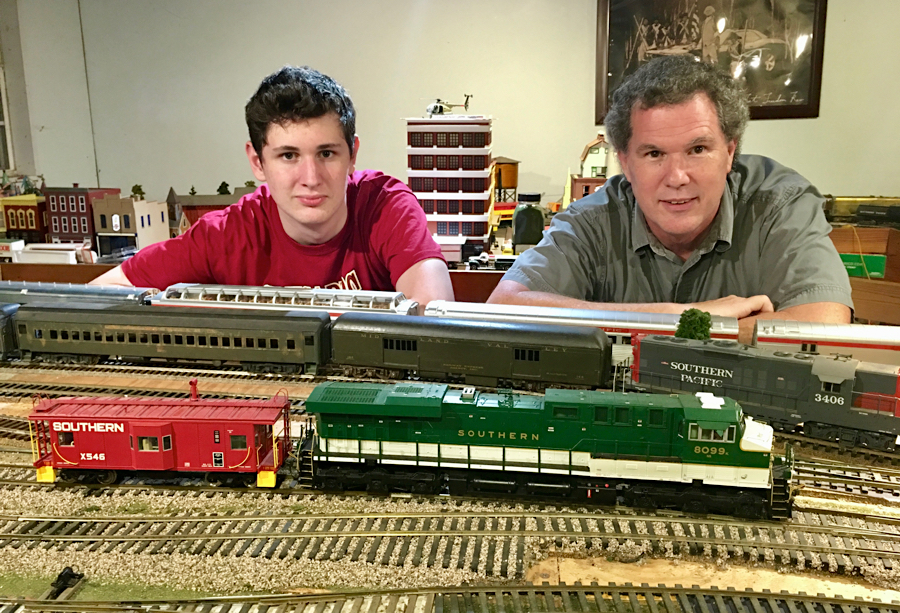
Marrero, La / Dec 2016 / RWH
O Scale Memories
For those model railroaders who grew with their hobby in the 1950s and 1960s, names like Lobaugh, Central Locomotive Works, All Nation, Kemtron and Walthers were sources of models, kits, material, supplies and more. The Louisiana, Texas and Pacific Railroad O scale layout had its beginnings in the 1970s, when Walthers and All Nation were still around, but new names like AHM and Atlas were on the hobby shop shelves.
 My first O scale 2-rail locomotive was an Atlas WDT six-wheel diesel switcher that I got by mail in 1973. After playing with my Lionel sets for a couple of years, the Atlas WDT was an amazing scale model, with small flanges, slow speeds (relatively speaking) and 2-rail running. Now more than 40 years old, the WDT is still part of my collection and it still runs.
My first O scale 2-rail locomotive was an Atlas WDT six-wheel diesel switcher that I got by mail in 1973. After playing with my Lionel sets for a couple of years, the Atlas WDT was an amazing scale model, with small flanges, slow speeds (relatively speaking) and 2-rail running. Now more than 40 years old, the WDT is still part of my collection and it still runs.
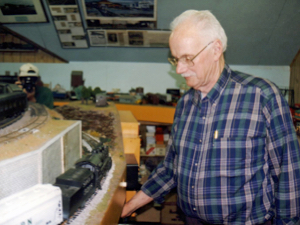 I followed up with an Atlas F9. Several Atlas plastic cars were in the mix, along with some Atlas track and switches. I was hooked by the size, smoothness, detail and sound of O scale as represented by Atlas. All the models were produced by Roco in Austria, with great quality (if not the best design - a discussion for other times) and durability. Most of the cars and even some of the track is still in use.
I followed up with an Atlas F9. Several Atlas plastic cars were in the mix, along with some Atlas track and switches. I was hooked by the size, smoothness, detail and sound of O scale as represented by Atlas. All the models were produced by Roco in Austria, with great quality (if not the best design - a discussion for other times) and durability. Most of the cars and even some of the track is still in use.
As these web pages on the LT&P O scale layout develop, Ralph and I will look into some of the history of O scale as it relates to our personal journeys. Ralph and I share many similar interests and perhaps the most important guide on this journey, Ralph's dad John.
John was what I always thought of as a well-rounded train fan. He liked to ride real trains, to model, to attend shows, and to host our monthly Southeast Louisiana Model Railroad Club meetings and run sessions. John's influence is all over the LT&P, in both the O scale layout and in the riding railroad. I will remind readers of this as these pages grow.
Gordon Payne / July 2017

Marrero, La / Dec 2016 / RWH
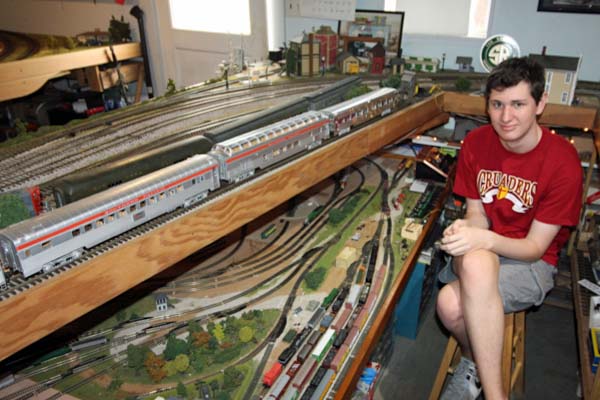
Marrero, La / Dec 2016 / RWH

It's easy to mock model railway enthusiasts as the dull cousin of train spotters, but the truth is that attics and spare rooms across the nation are filled with small buildings and model engines. So what is it about the guilty pleasure of building tiny tracks and watching tiny trains zip around them that is so appealing?
Mike Hughes is the Marketing Director for the British branch of the National Model Railroad Association (NMRA). He believes that constructing model railway tracks is a "hobby that transcends generations" and encourages people to nurture a wide range of skills as problem solvers.
"It's a complete range of skills," says Hughes, 68. "You can begin by researching the different railways and trains, and then of course a great deal of skill goes into the planning. Woodworking skills are required to lay the track and then electrical skills to successfully install all the wiring. You improve your artistic and modelling skills as you build as well. People think that they're toys, but it does take a great deal of skill. They're anything but toys these days."
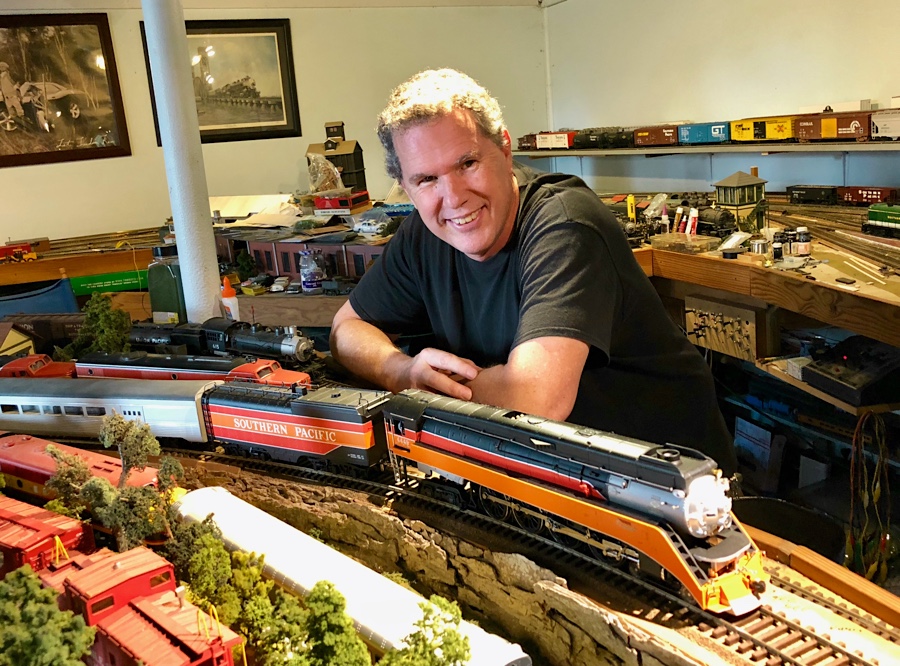
Marrero, La / Dec 2017 / RWH
Layout

Dec 2016 / RWH
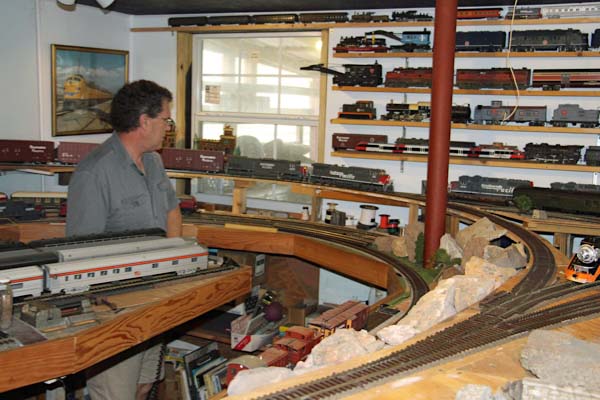
Dec 2016 / RWH
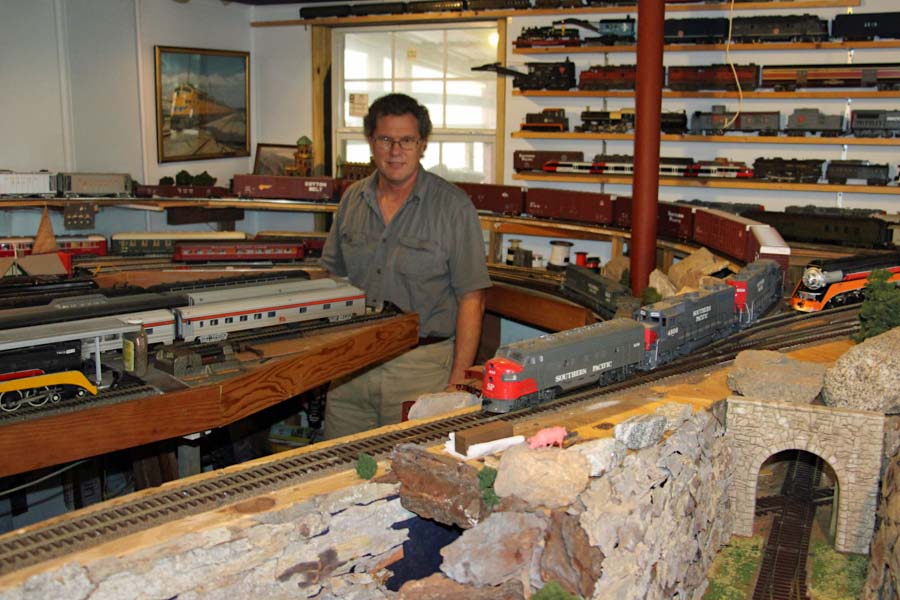
Dec 2016 / RWH
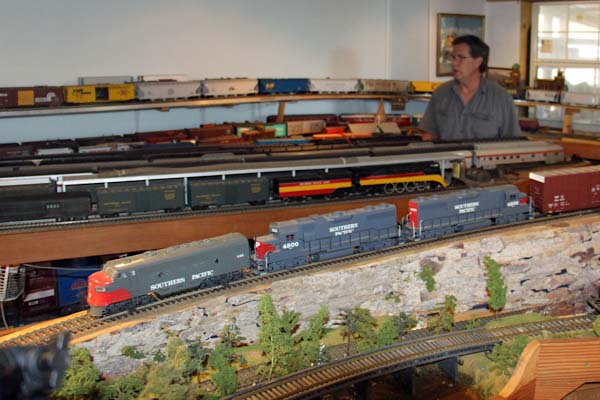
Dec 2016 / RWH

Dec 2016 / RWH

Dec 2016 / RWH
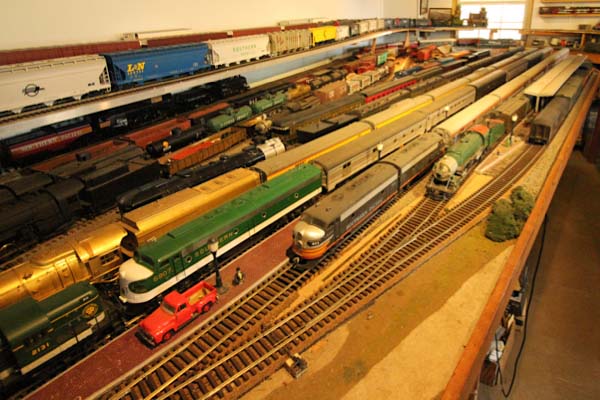
Dec 2016 / RWH

Dec 2016 / RWH
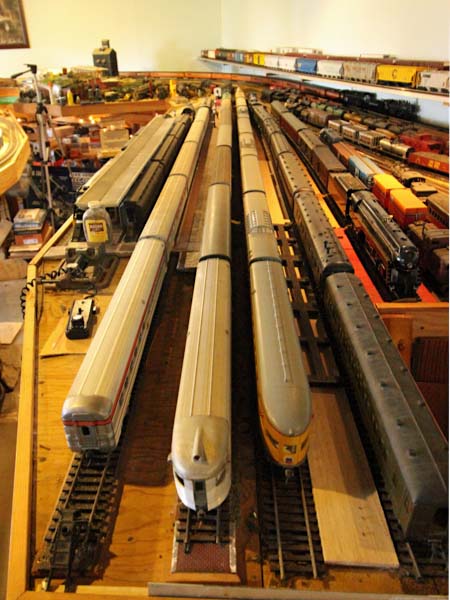
Dec 2016 / RWH
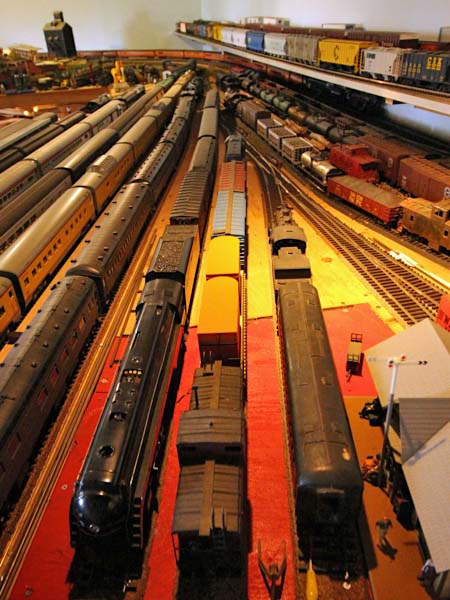
Dec 2016 / RWH
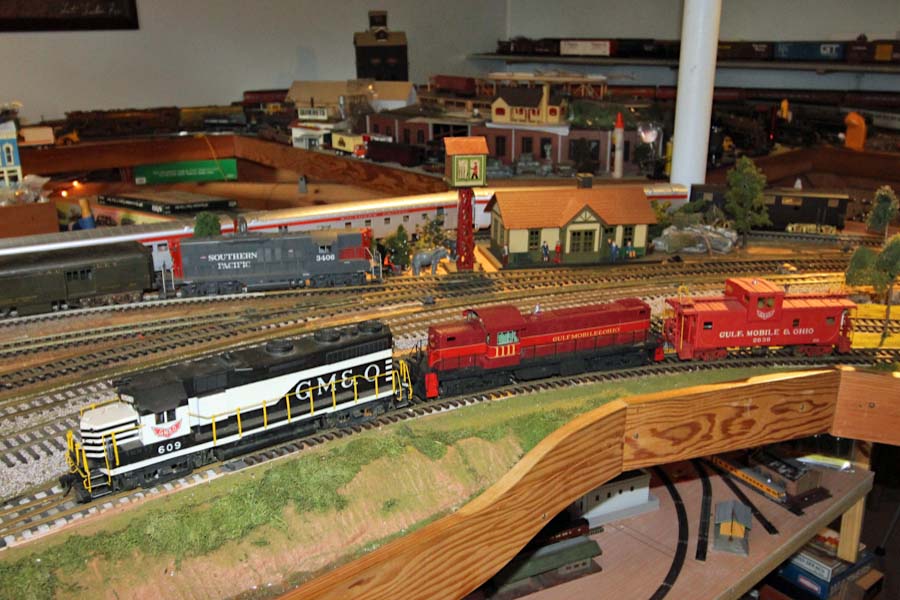
Dec 2016 / RWH
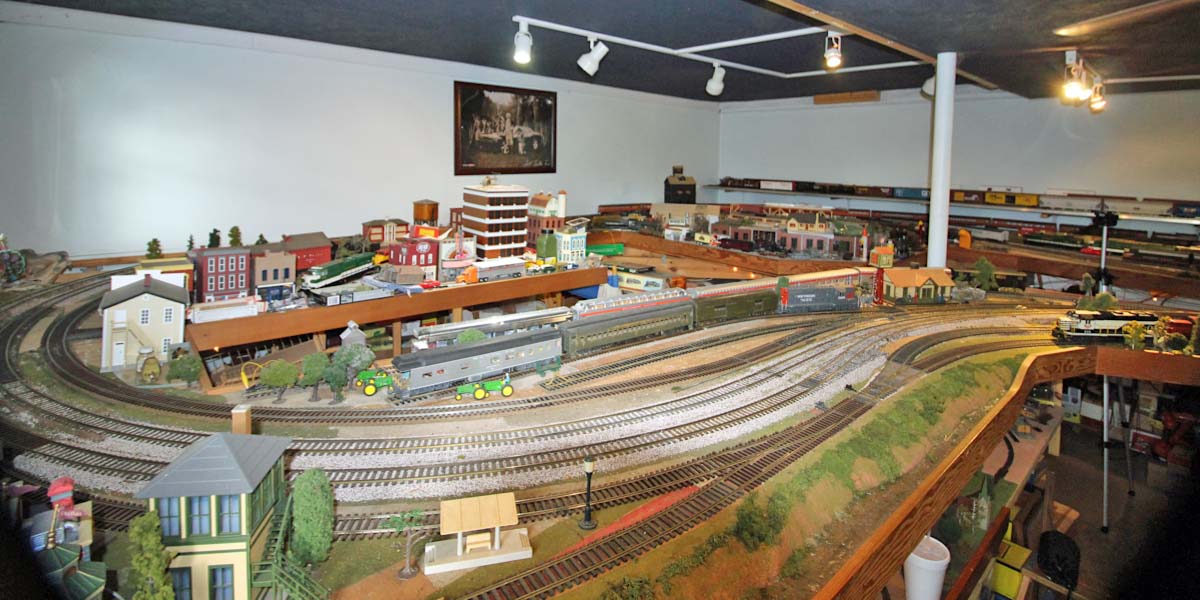
Dec 2016 / RWH
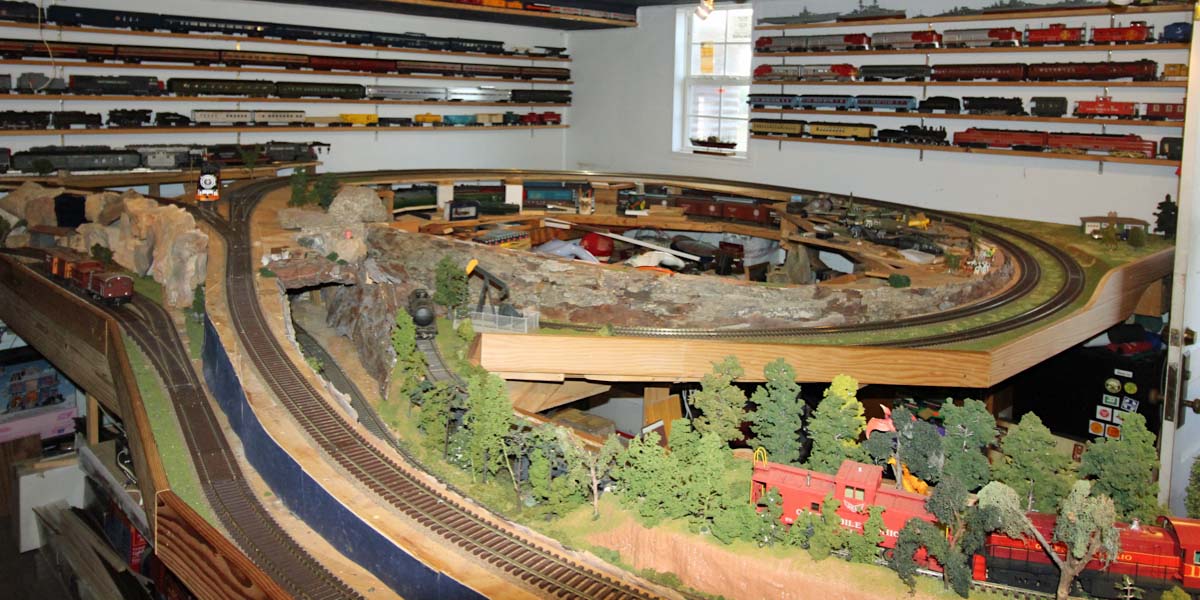
Dec 2016 / RWH
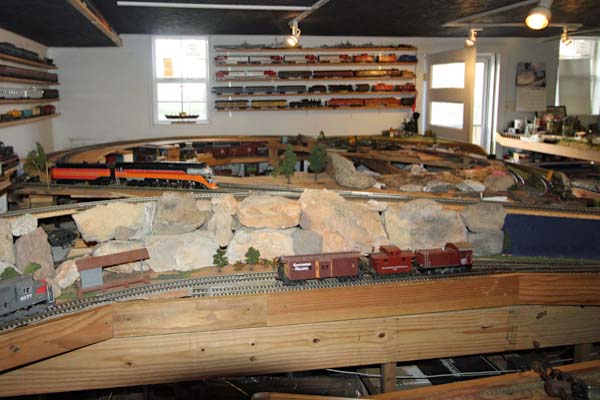
Dec 2016 / RWH
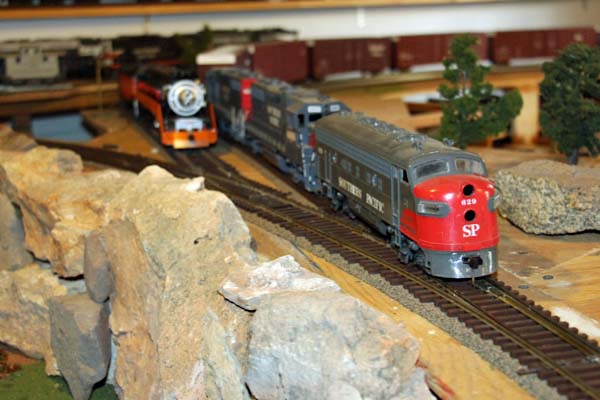
Dec 2016 / RWH
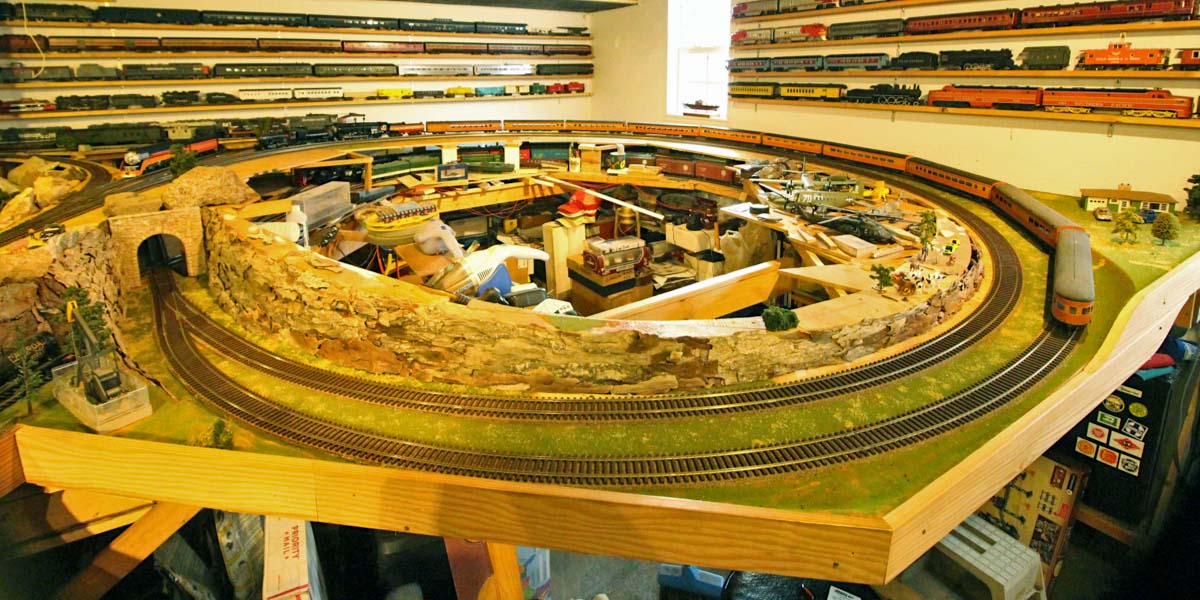
Dec 2016 / RWH
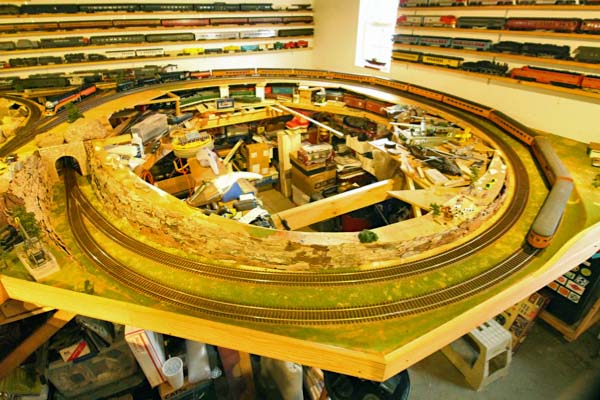
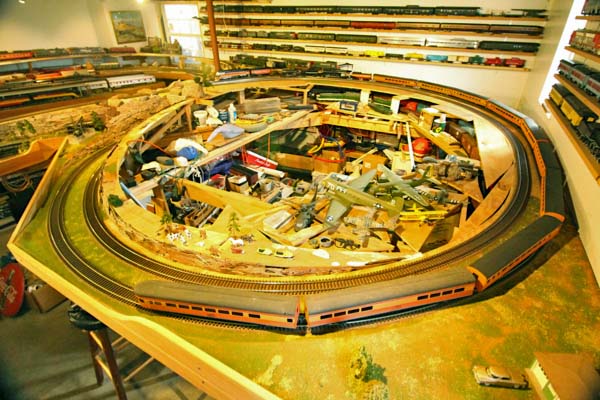
Dec 2016 / RWH
 HawkinsRails Tour
HawkinsRails Tour
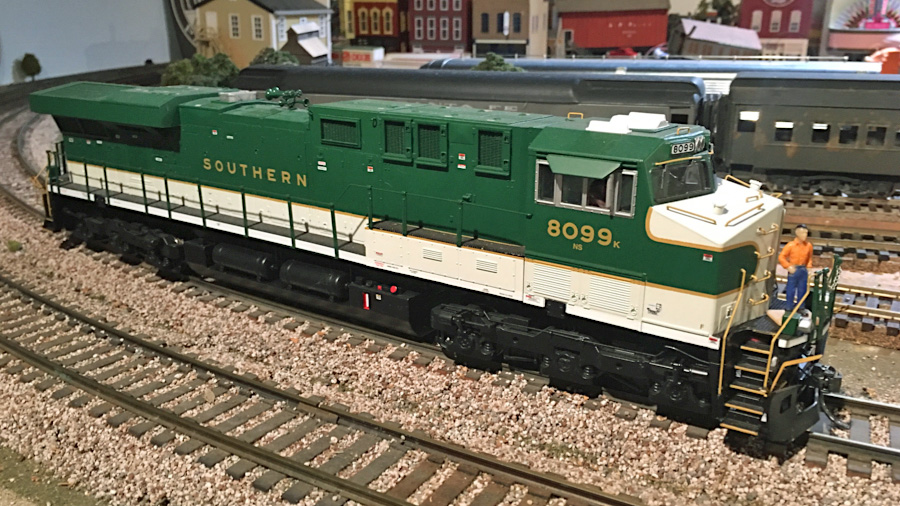
Dec 2016 / RWH

As the Assistant Second Vice President for Media Relations and Web Design of the Louisiana, Texas & Pacific Railroad, I feel it is important to inspect the railroad from time to time from the working man's point of view. In December 2016, I took an inspection tour of the Indoor Division, hosted by LT&P General Superintendent and Master Mechanic G. Payne, as well as Road Foreman of Engines and President of the affiliated N Scale lines, J. Payne. As shown here (I'm the guy in the orange safety shirt), I was driven in an LT&P MOW vehicle to numerous points along the Indoor Division right-of-way to capture updated photos of this busy railroad in action. Of course the Southern heritage unit was a real treat to see in person, but the highlight of this visit was standing trackside while long passenger movements traversed the impressive Tehachapi Loop district. The Indoor Division is well known for its numerous passenger trains -- You should see the LT&P's Daylight rendition curved around the Loop and almost crossing itself! -- and this day's running did not disappoint. Traffic was heavy all day, but the dispatchers delivered and all went well. The Indoor Division once again confirmed why 1:48 has been, and will remain, the "King of All Scales." On your next trip, take a ride on the LT&P.
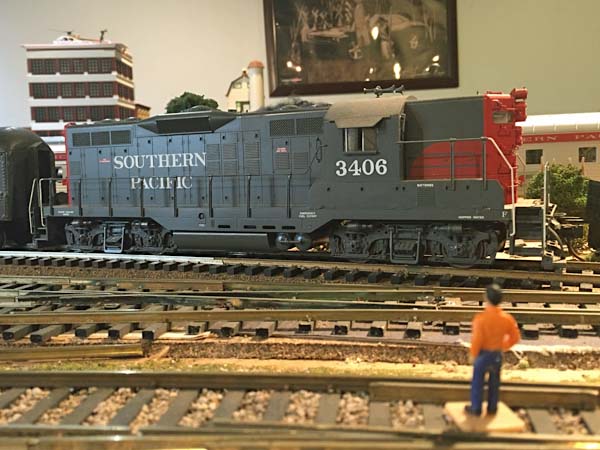

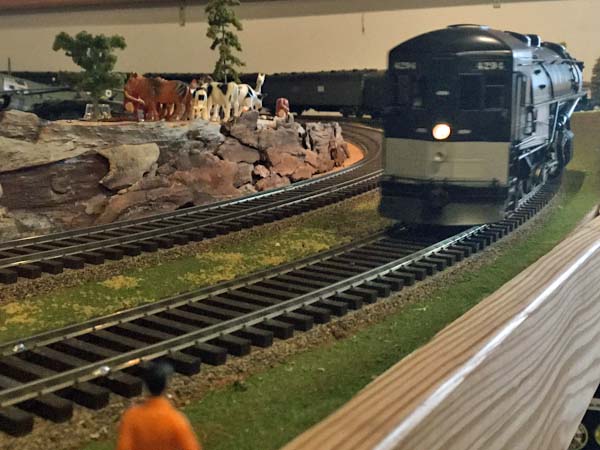
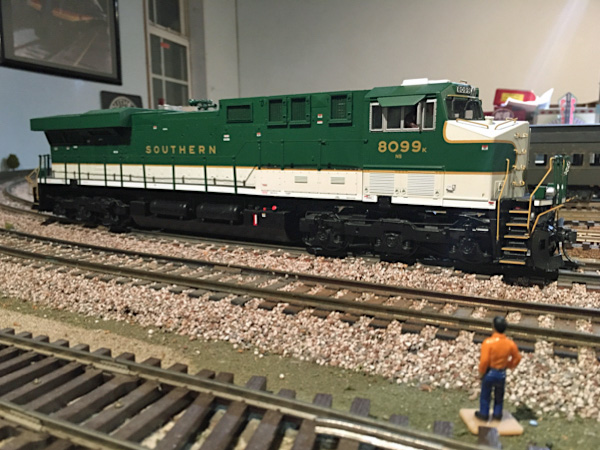
Dec 2016 / RWH
Locomotives

Southern Pacific #4294
Dec 2016 / RWH
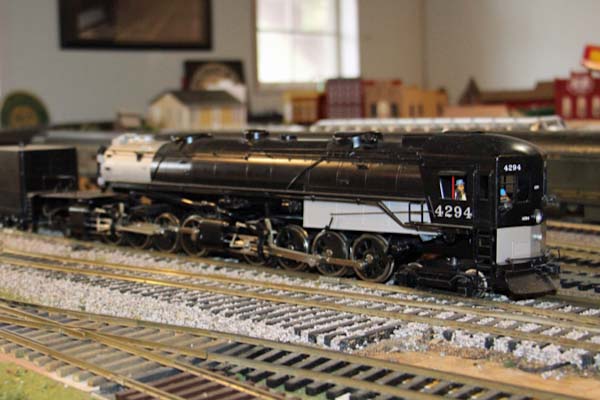
Southern Pacific #4294
Dec 2016 / RWH
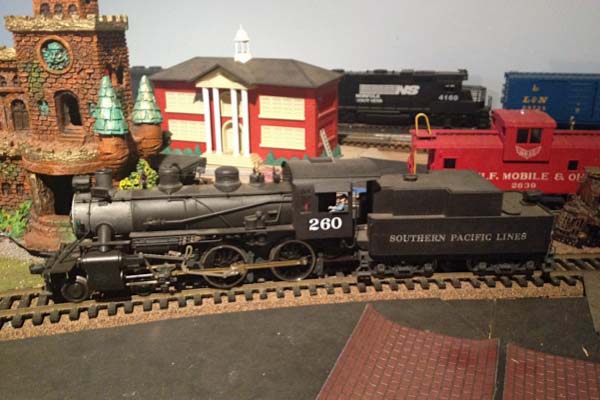
Southern Pacific #260
Feb 2012 / RWH
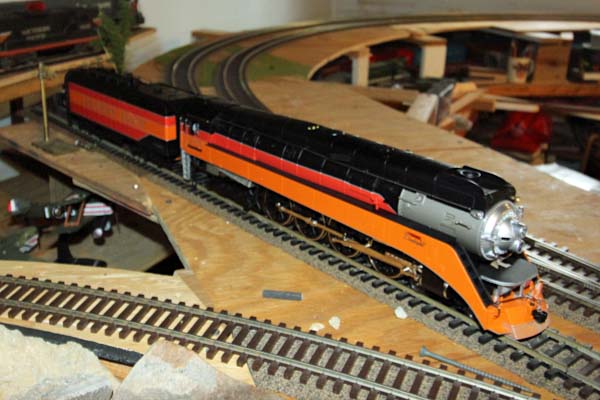
Dec 2016 / RWH
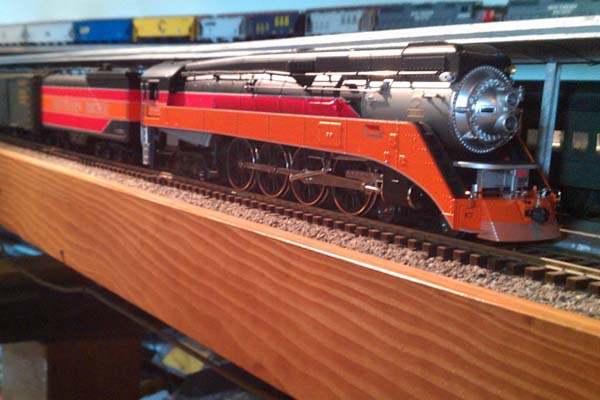
Mar 2017 / Gordon Payne
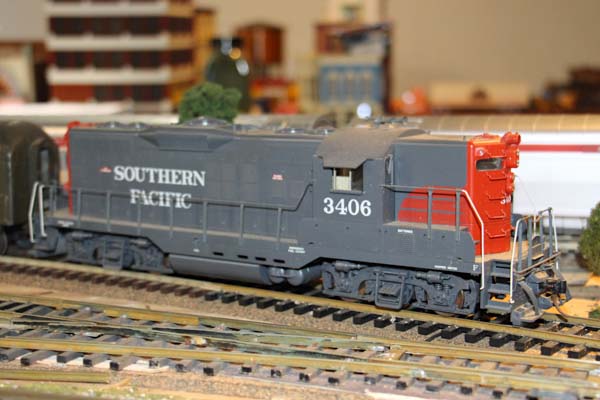
Southern Pacific #3406
Dec 2016 / RWH
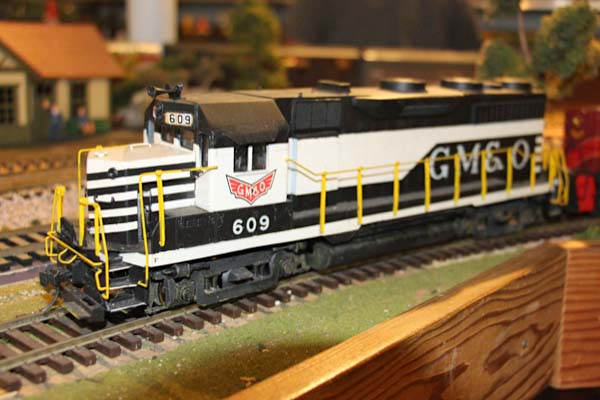
Gulf, Mobile & Ohio #609
Dec 2016 / RWH
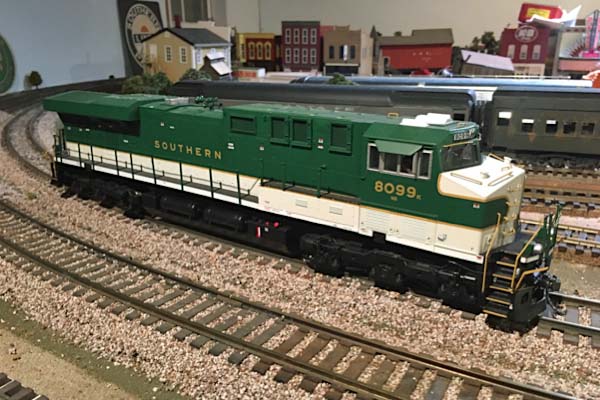
Norfolk Southern #8099
Dec 2016 / RWH

Union Pacific #4020
Mar 2017 / Gordon Payne
Structures
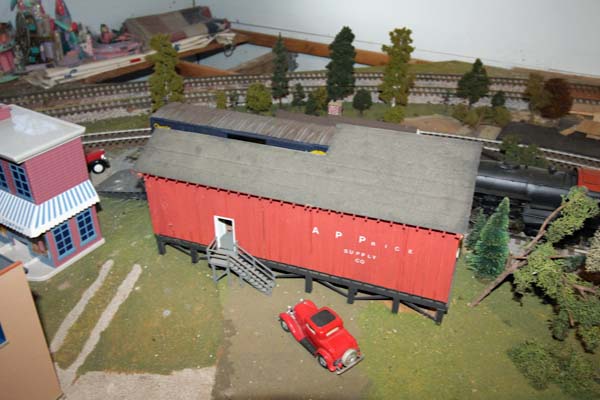
A. P. Price Supply Co.
Dec 2016 / RWH
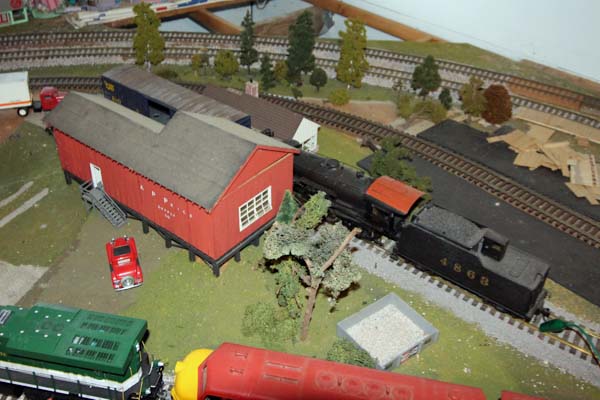
Dec 2016 / RWH
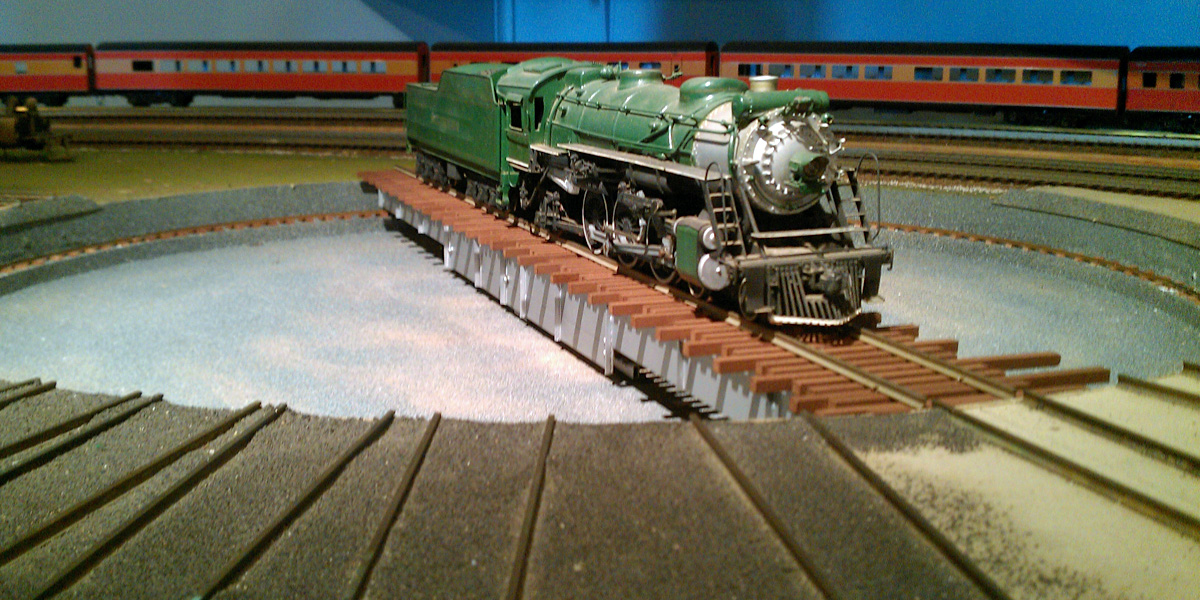
Turntable
Apr 2017 / Gordon Payne
Video
Dec 2016 / RWH
